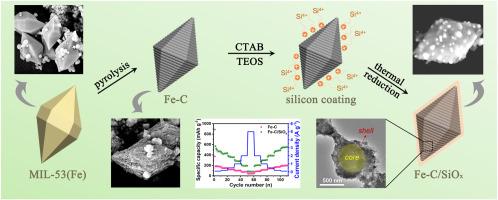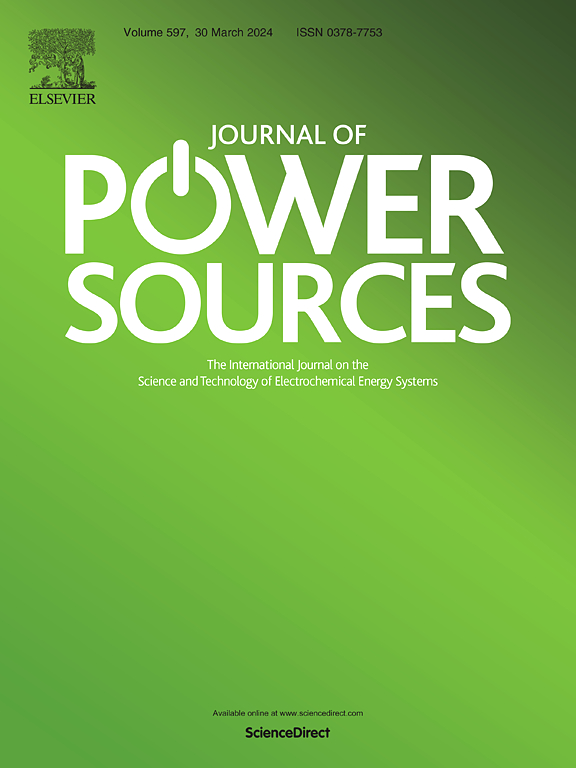Novel Fe-compound incorporating porous carbon substrate promoting electrochemical performance of SiOx anodes for lithium-ion batteries
IF 8.1
2区 工程技术
Q1 CHEMISTRY, PHYSICAL
引用次数: 0
Abstract
Silicon oxide (SiOx) shows great potential to be used in grid energy storage as the high-energy density anodes for lithium-ion batteries (LIBs) due to its low cost and high theoretical capacity. While the issues like low conductivity and volume expansion during cycles significantly decay the battery rate capability and cycle stability. To address the overall challenges, we effectively modified SiOx hybrid structure by introducing metal incorporating porous carbon, derived from metal-organic frameworks (MOFs), denoted as Fe-C/SiOx. The core-shell structure, coupled with the unique properties of both Fe-C and SiOx components, offers a synergistic effect that effectively mitigates volume expansion and low conductivity problems, resulting in significant improvements in electrochemical performance. A discharge capacity of 658 mAh g−1 at 100 mA g−1 and an initial coulombic efficiency of 60 % are achieved. Additionally, it exhibits long-term cyclic stability with capacity of 650 mAh g−1 after 300 cycles at 100 mA g−1, and 337 mAh g−1 after 500 cycles at 500 mA g−1. The lithium ion storage mechanism investigation suggests conductive matrix of porous Fe-C primarily facilitates enhanced lithium-ion diffusion dynamics and offers pseudocapacitance to the electrode, which is crucial for practical battery applications where fast charging and discharging are required.

含有多孔碳基底的新型铁化合物可提高锂离子电池氧化硅阳极的电化学性能
氧化硅(SiOx)因其低成本和高理论容量,作为锂离子电池(LIB)的高能量密度阳极,在电网储能方面显示出巨大的应用潜力。然而,低电导率和循环过程中的体积膨胀等问题严重影响了电池的速率能力和循环稳定性。为了应对这些挑战,我们通过引入金属有机框架(MOFs)中的多孔碳,有效地改进了 SiOx 混合结构,并将其命名为 Fe-C/SiOx。核壳结构加上 Fe-C 和 SiOx 成分的独特性能,产生了协同效应,有效缓解了体积膨胀和低导电率问题,从而显著提高了电化学性能。在 100 mA g-1 的条件下,放电容量达到 658 mAh g-1,初始库仑效率达到 60%。此外,它还表现出长期循环稳定性,在 100 mA g-1 条件下循环 300 次后容量达到 650 mAh g-1,在 500 mA g-1 条件下循环 500 次后容量达到 337 mAh g-1。锂离子存储机理研究表明,多孔 Fe-C 的导电基质主要有利于增强锂离子扩散动力学,并为电极提供假电容,这对于需要快速充放电的实际电池应用至关重要。
本文章由计算机程序翻译,如有差异,请以英文原文为准。
求助全文
约1分钟内获得全文
求助全文
来源期刊

Journal of Power Sources
工程技术-电化学
CiteScore
16.40
自引率
6.50%
发文量
1249
审稿时长
36 days
期刊介绍:
The Journal of Power Sources is a publication catering to researchers and technologists interested in various aspects of the science, technology, and applications of electrochemical power sources. It covers original research and reviews on primary and secondary batteries, fuel cells, supercapacitors, and photo-electrochemical cells.
Topics considered include the research, development and applications of nanomaterials and novel componentry for these devices. Examples of applications of these electrochemical power sources include:
• Portable electronics
• Electric and Hybrid Electric Vehicles
• Uninterruptible Power Supply (UPS) systems
• Storage of renewable energy
• Satellites and deep space probes
• Boats and ships, drones and aircrafts
• Wearable energy storage systems
 求助内容:
求助内容: 应助结果提醒方式:
应助结果提醒方式:


